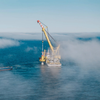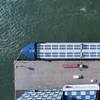Feeder Containerships to Use Hybrid Power
The IMO's mandate to reduce emissions 50% by 2050 has spurred collaboration in the maritime power sector, with the likes of MAN Energy Solutions, Corvus Energy, DNV GL and HYCAS announcing earlier this year astudy of a hybrid solution that uses batteries in a container feeder vessel, assessing savings in both emissions and costs.
Dr Alexander Knafl, MAN Energy Solutions, presented the results of a new study which examines examines the cost effectiveness of hybrid power solutions in a 1,700 TEU container feeder vessel.the potential of hybrid power solutions in light of tightening regulations on greenhouse gas (GHG) emissions.
\“There were several factors that went into the selection of a container feeder vessel for the study,” said Hans Anton Tvete, DNV GL.
“We were looking at where hybrid systems could offer significant efficiency gains, which pointed to operational states with fluctuating power demand. This typically occurs with large consumers such as cranes, pumps, ventilation fans, or maneuvering equipment, especially in port. Container feeders, with their frequent port stays and increased time in port, are ripe for efficiency gains through the use of hybrid solutions. Also, as this fleet is aging, new tonnage is likely to be on order in the near future,” Tvete said.
“Focusing on a container feeder vessel we were able to generate a typical propulsion power profile from vessel speed data, as well as an artificial time-resolved electrical load profile from the according electrical load table. These are the most important inputs for the MAN simulation tool ECO-ESS. Together with the specific battery and engine characteristics, it is possible to optimize the size of a battery in a hybrid propulsion system for the 2020 and 2030 scenario as an optimum of additional CAPEX and OPEX savings.” says Carina Kern, MAN Energy Solutions.
The study explored two main scenarios, a vessel built in 2020 with a 500kWh battery system replacing one genset used for peak shaving and as a spinning reserve, and a vessel built in 2030, using a much larger 11MWh hybrid system for zero emission port entry and exit.
Under the first scenario, with the hybrid power train resulting in an approximately 13% total cost for the vessel, payback times are as low as two to three years. However, the larger system increases the costs of the vessel significantly, meaning that only with a combination of lower prices for the battery system and higher fuel costs than today would the system be economically attractive.











